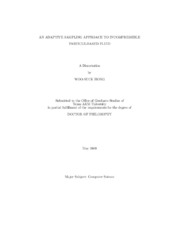| dc.description.abstract | I propose a particle-based technique for simulating incompressible
uid that
includes adaptive re nement of particle sampling. Each particle represents a mass
of
uid in its local region. Particles are split into several particles for ner sampling
in regions of complex
ow. In regions of smooth
ow, neghboring particles can be
merged. Depth below the surface and Reynolds number are exploited as our criteria
for determining whether splitting or merging should take place. For the
uid dynamics
calculations, I use the hybrid FLIP method, which is computationally simple and
e cient. Since the
uid is incompressible, each particle has a volume proportional to
its mass. A kernel function, whose e ective range is based on this volume, is used for
transferring and updating the particle's physical properties such as mass and velocity.
In addition, the particle sampling technique is extended to a fully adaptive approach,
supporting adaptive splitting and merging of
uid particles and adaptive spatial sampling
for the reconstruction of the velocity and pressure elds. Particle splitting allows
a detailed sampling of
uid momentum in regions of complex
ow. Particle merging,
in regions of smooth
ow, reduces memory and computational overhead. An
octree structure is used to compute inter-particle interactions and to compute the
pressure eld. The octree supporting eld-based calculations is adapted to provide a ne spatial reconstruction where particles are small and a coarse reconstruction
where particles are large. This scheme places computational resources where they are
most needed, to handle both
ow and surface complexity. Thus, incompressibility
can be enforced even in very small, but highly turbulent areas. Simultaneously, the
level of detail is very high in these areas, allowing the direct support of tiny splashes
and small-scale surface tension e ects. This produces a nely detailed and realistic
representation of surface motion. | en |


